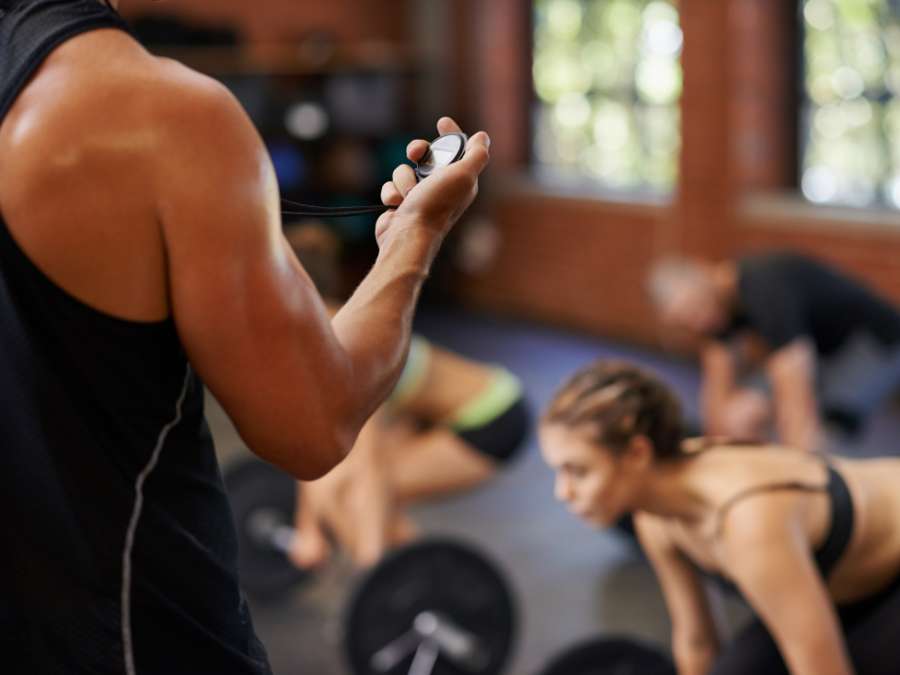Ever heard the term “PR” in the gym? It stands for Personal Record, signifying your best performance in a specific exercise or workout to date.
As experienced fitness professionals, we combine practical expertise with in-depth knowledge to offer reliable insights and advice.
Whether motivating your team or enhancing training programs, PR plays a crucial role in fostering motivation, tracking progress, and achieving fitness goals.
In this guide, we will discover how PRs can unlock potential and elevate performance to the next level.
So let’s get down to it!
Table of Contents
1. What Does PR Stand For in the Gym?
Personal Record (PR) is a crucial term in the fitness world, denoting the best performance an individual has achieved in a specific exercise or activity. Whether lifting weights, running a certain distance, or completing a workout in a designated time, PRs serve as benchmarks for progress. But that’s not all because understanding and tracking PRs is vital for setting goals, maintaining motivation, and measuring improvements in fitness.

2. Benefits of Tracking PRs
Tracking personal records (PRs) provides numerous advantages that can significantly enhance fitness progress. Here are some key benefits along with actionable tips for improving PRs:
Enhanced Motivation
Monitoring progress fosters motivation. Setting specific PR goals encourages individuals to push their limits and stay committed to their training. Seeing tangible improvements over time can create a sense of achievement that fuels further efforts.
Improved Goal Setting
Regularly tracking PRs helps establish clear, achievable goals. This clarity streamlines training efforts, making it easier to focus on specific outcomes. By breaking down larger goals into smaller, manageable steps, individuals can maintain a sense of direction in their fitness journey. With the right equipment from YR Fitness, clients can better align their training with their goals.
Better Accountability
Having a record of PRs creates accountability, encouraging more disciplined training routines. When individuals track their progress, they are more likely to stick to their plans and push themselves to meet their targets.
Identifying Strengths and Weaknesses
Tracking PRs reveals patterns in performance, helping individuals identify areas for improvement. This insight allows for targeted adjustments in training, focusing on weaknesses that may be holding back progress.
Encouraging Consistency
Regularly recording progress promotes a consistent workout routine, which is crucial for achieving PRs. Establishing a habit of tracking workouts helps individuals stay engaged with their training plans.

3. Types of PRs in Fitness
Different types of personal records can be tracked, depending on the specific fitness activities involved. So yes, recognizing these various categories can help individuals set targeted goals and monitor their progress effectively. Here are the main types of PRs in fitness:
Strength PRs
Strength PRs refer to the maximum weight lifted in specific exercises. Here are notable examples:
- Squats: Tracking the heaviest weight lifted in a squat, indicating leg strength and overall lower body power.
- Deadlifts: Monitoring progress in lifting heavier loads, showcasing back, leg, and grip strength.
- Bench Press: Recording the best weight lifted while performing bench presses, reflecting upper body strength and stability.

Endurance PRs
Endurance PRs measure performance over time and distance in cardio activities. Here are some options:
- Running: Best time for a 5K or 10K run, assessing cardiovascular fitness and speed.
- Cycling: Fastest time or longest distance covered within a set timeframe, evaluating leg endurance and cycling efficiency.
- Swimming: Personal best times for specific distances, demonstrating swimming technique and aerobic capacity.

Rep-Max PRs
Rep-Max PRs refer to the maximum weight that can be lifted for a specific number of repetitions. Here are some examples:
- Five-Rep Max: Determining how much weight can be lifted for five reps, useful for building strength endurance.
- Ten-Rep Max: Assessing weight capacity for ten repetitions, providing insight into muscle endurance and hypertrophy potential.
- One-Rep Max (1RM): Finding the heaviest weight that can be lifted once, critical for strength training benchmarks.

Volume PRs
Volume PRs track the total amount of weight lifted over a session or period. This can be detailed as follows:
- Total Volume Lifted: Calculating the total weight lifted across all sets and reps in a workout, reflecting training intensity and workload.
- Weekly Volume: Monitoring the cumulative weight lifted over a week, helping to evaluate training consistency and progression.
- Monthly Progress: Analyzing volume changes over an extended period, providing insights into overall training effectiveness.

Time-Based PRs
Time-Based PRs measure performance based on the time taken to complete an activity. This includes:
- Workout Duration: Best time to complete a specific workout routine, indicating efficiency and pacing.
- Distance Challenges: Fastest time to run a specific distance, like a mile or 5K, highlighting speed and endurance capabilities.
- Interval Training: Best time for completing intervals in high-intensity workouts, showcasing anaerobic capacity and recovery efficiency.

Technique PRs
Technique PRs focus on mastering the correct form or skill in a specific exercise. Notable examples are:
- Olympic Lifts: Successfully performing clean and jerk or snatch with proper technique, essential for safety and performance.
- Complex Movements: Mastering advanced skills like muscle-ups or handstands, which require coordination and strength.
- Flexibility Goals: Achieving proper form in challenging yoga poses or stretches, indicating progress in flexibility and mobility.

4. Tools and Technology for PR Tracking
Utilizing the right tools and technology is essential for effectively tracking personal records. Various options are available to help individuals log achievements, analyze performance, and stay motivated. Here are some valuable tools and technologies for PR tracking:
Fitness Apps
Fitness apps have become essential for tracking workouts and managing personal records. This technology-driven approach is driving significant growth in the apps market, with projections showing an increase from $15.0 billion in 2022 to $34.3 billion by 2027, according to BCC Research. Here are some key benefits:
- User-Friendly Interfaces: Most apps are designed to be intuitive, allowing users to quickly log exercises and weights.
- Goal Setting: Many apps enable users to set specific fitness goals, such as achieving a new PR in a particular exercise.
- Progress Graphs: Visualization tools help users see trends over time, making it easy to understand improvements.
- Community Features: Some apps offer social components, allowing users to connect with others for motivation and support.
Popular fitness apps include:
- MyFitnessPal: Focuses on nutrition tracking but also allows users to log workouts.
- Strava: Primarily for runners and cyclists, Strava offers detailed metrics and performance tracking.
- Fitbod: Provides personalized workout recommendations based on past performance and available equipment.
Wearable Devices
Wearable devices, such as smartwatches and fitness trackers, are invaluable for real-time tracking of workouts and health metrics. Fact is, these devices often include features that support PR tracking:
- Activity Tracking: Most wearables monitor daily activities, including steps, heart rate, and calories burned.
- Workout Modes: Users can select specific modes for various activities, allowing for accurate tracking of different exercises.
- Performance Metrics: Devices provide insights into metrics like pace, distance, and recovery time, helping users gauge their performance effectively.
Popular wearable devices include:
- Fitbit: Offers a variety of models with features like heart rate monitoring and sleep tracking.
- Garmin: Known for its GPS capabilities, particularly useful for runners and cyclists.
- Apple Watch: Combines fitness tracking with smartwatch functionality, providing a comprehensive fitness experience.
Spreadsheets
For those who prefer a more hands-on approach, spreadsheets can be an effective tool for tracking PRs. They allow for customization and detailed record-keeping:
- Customizable Templates: Users can create personalized templates that fit their specific workout routines and PR tracking needs.
- Data Analysis: Spreadsheets can be used to analyze trends over time, helping individuals identify patterns in their training and progress.
- Historical Records: By maintaining a long-term log of workouts, individuals can review their fitness journey and celebrate milestones.
Creating a simple spreadsheet might include columns for:
- Exercise type
- Date of achievement
- Weight lifted or time recorded
- Notes on performance or training conditions
Online Communities and Forums
Online communities and forums dedicated to fitness can also serve as valuable resources for tracking PRs. Engaging with others can provide:
- Accountability: Sharing progress with a community can help individuals stay committed to their fitness goals.
- Advice and Tips: Community members often share strategies for breaking through plateaus or achieving new PRs.
- Motivation: Celebrating others’ achievements can inspire individuals to push for their own personal records.
Popular websites include:
- Reddit: Various fitness-related subreddits for community support and advice.
- Bodybuilding.com: Forums for discussions, tips, and progress tracking.
- Facebook Groups: Numerous groups focused on specific fitness goals and sharing experiences.
5. Common Challenges in Achieving PRs
While tracking PRs is beneficial, various challenges may arise that can hinder progress. Recognizing these obstacles is the first step in overcoming them. Here are some common challenges faced when striving to achieve PRs.
Plateaus
Plateaus are a common challenge where individuals find it difficult to achieve new records despite consistent effort. The problem is this can lead to frustration and a lack of motivation. Overcoming plateaus often requires adjustments in training, such as varying workouts or increasing recovery time.
Injury Risks
The pursuit of new personal records can increase the risk of injury if not approached with caution. It’s essential to prioritize proper form, warm-up adequately, and listen to the body to prevent setbacks that could derail progress.
| Injury Risk | Common Causes | Prevention Strategies |
| Muscle Strains | Overexertion, improper warm-up, fatigue. | – Always warm up adequately before workouts. |
| – Gradually increase intensity and volume. | ||
| – Include flexibility exercises. | ||
| Joint Injuries | Poor form, repetitive stress, inadequate recovery. | – Prioritize proper technique and form. |
| – Use supportive equipment (e.g., braces, shoes). | ||
| – Allow sufficient recovery time between sessions. | ||
| Tendonitis | Overuse, sudden increases in training intensity. | – Gradually progress in weight or repetitions. |
| – Incorporate rest days and cross-training. | ||
| – Perform specific strengthening exercises for vulnerable tendons. | ||
| Back Injuries | Lifting heavy weights incorrectly, lack of core strength. | – Focus on core strengthening exercises. |
| – Maintain proper lifting techniques (e.g., squat with legs, not back). | ||
| – Avoid lifting too heavy too soon. | ||
| Stress Fractures | Overtraining, inadequate nutrition, poor footwear. | – Monitor training loads and allow rest periods. |
| – Make sure of a balanced diet with adequate calcium and vitamin D. | ||
| – Use appropriate footwear for specific activities. |
Consistency
Achieving PRs demands regular training and commitment. Life’s distractions can make it challenging to maintain a consistent workout schedule, which may hinder the ability to reach new goals. Having quality equipment from YR Fitness can help facilitate this consistency.
Mental Barriers
Fear of failure or self-doubt can be significant obstacles in the quest for new PRs. Mental preparation, visualization techniques, and a positive mindset can help individuals overcome these barriers and stay focused on their goals. For example, visualizing successful attempts at lifting heavier weights can boost confidence and reduce anxiety before workouts.
Conclusion
Understanding what “PR” means in the gym helps clients set clear fitness goals. It stands for personal records, which encourages gym-goers to reach new levels. Recognizing this term can inspire a stronger focus on performance.
In conclusion, this guide highlights the value of knowing personal records in fitness. If you’re looking for reliable commercial gym equipment to support those goals, YR Fitness offers the best tools. Contact us to learn more!
Related articles:





